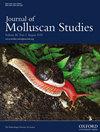Molecular delimitation of cryptic Australian squid species of the genus Uroteuthis Rehder, 1945 (Cephalopoda: Loliginidae), provides a baseline of diversity to resolve classification challenges throughout the Indo-Pacific
IF 1.2
4区 生物学
Q2 MARINE & FRESHWATER BIOLOGY
引用次数: 0
Abstract
This study provides a comprehensive molecular phylogenetic analysis of Uroteuthis squid from the Indo-Pacific region. The main aim was to increase sample coverage from northern and eastern Australian waters to resolve the identity and distribution of Uroteuthis species taken by local fisheries. Two mitochondrial regions, cytochrome c oxidase subunit I (COI) and 16S ribosomal RNA (16S rRNA), were sequenced from 220 new specimens and analysed with a further 51 sequences from GenBank to create a combined phylogeny for the genus. Three nuclear regions, 18S ribosomal DNA (18S rDNA), 28S ribosomal DNA (28S rDNA) and rhodopsin, were also sequenced from representatives of each species. Based on the mitochondrial phylogeny plus distance and tree-based delimitation models, a COI species barcode gap of 4–5% is proposed for discriminating Uroteuthis species. Applying this gap partitioned many described species into species complexes; for example, U. duvaucelii, U. noctiluca and U. edulis resolved into 10 species. Although more conserved, mitochondrial 16S rRNA sequences differentiated all new species clades, whereas none of the nuclear markers resolved the closest species. Results confirm that neither U. chinensis nor U. edulis occurs in Australian waters. Five undescribed species are identified from northern and eastern Australia, of which four are consistent with earlier allozyme studies (and two align with existing DNA sequences). One is a new southeastern, deeper shelf species differentiated in this study, along with a sixth undescribed species from Indonesian waters. Results of the molecular analysis are now being used to inform complementary morphometric analyses for new species descriptions, and genetic stock structure assessments of these important fisheries resources.Uroteuthis Rehder, 1945 属(头足目:鱿鱼科)澳大利亚隐蔽鱿鱼物种的分子定界为解决整个印度洋-太平洋地区的分类难题提供了多样性基线
这项研究对印度洋-太平洋地区的乌贼进行了全面的分子系统学分析。主要目的是扩大澳大利亚北部和东部水域的样本覆盖范围,以确定当地渔业捕捞的乌贼物种的身份和分布。对 220 个新标本的两个线粒体区域,即细胞色素 c 氧化酶亚单位 I(COI)和 16S 核糖体 RNA(16S rRNA)进行了测序,并与 GenBank 中的另外 51 个序列进行了分析,从而建立了该属的综合系统发生。此外,还对每个物种的三个核区,即 18S 核糖体 DNA(18S rDNA)、28S 核糖体 DNA(28S rDNA)和菱形蛋白进行了测序。根据线粒体系统发育加上距离和基于树的划分模型,提出了用于区分 Uroteuthis 物种的 COI 物种条形码差距为 4-5%。例如,U. duvaucelii、U. noctiluca 和 U. edulis 可分为 10 个物种。尽管线粒体 16S rRNA 序列的保守性更强,但它还是将所有新物种支系区分开来,而没有一个核标记能区分出最接近的物种。结果证实,U. chinensis 和 U. edulis 都不存在于澳大利亚水域。在澳大利亚北部和东部发现了五个未被描述的物种,其中四个与早期的同工酶研究结果一致(两个与现有的 DNA 序列一致)。其中一个是本研究中分化出的东南部深海大陆架新物种,还有一个是来自印度尼西亚水域的第六个未被描述的物种。分子分析的结果目前正被用于新物种描述的补充形态分析,以及这些重要渔业资源的遗传种群结构评估。
本文章由计算机程序翻译,如有差异,请以英文原文为准。
求助全文
约1分钟内获得全文
求助全文
来源期刊

Journal of Molluscan Studies
生物-动物学
CiteScore
3.00
自引率
8.30%
发文量
36
审稿时长
3 months
期刊介绍:
The Journal of Molluscan Studies accepts papers on all aspects of the study of molluscs. These include systematics, molecular genetics, palaeontology, ecology, evolution, and physiology. Where the topic is in a specialized field (e.g. parasitology, neurobiology, biochemistry, molecular biology), submissions will still be accepted as long as the mollusc is the principal focus of the study, and not incidental or simply a convenient experimental animal. Papers with a focus on fisheries biology, aquaculture, and control of molluscan pests will be accepted only if they include significant advances in molluscan biology. While systematic papers are encouraged, descriptions of single new taxa will only be considered if they include some ‘added value’, for example in the form of new information on anatomy or distribution, or if they are presented in the context of a systematic revision or phylogenetic analysis of the group.
 求助内容:
求助内容: 应助结果提醒方式:
应助结果提醒方式:


